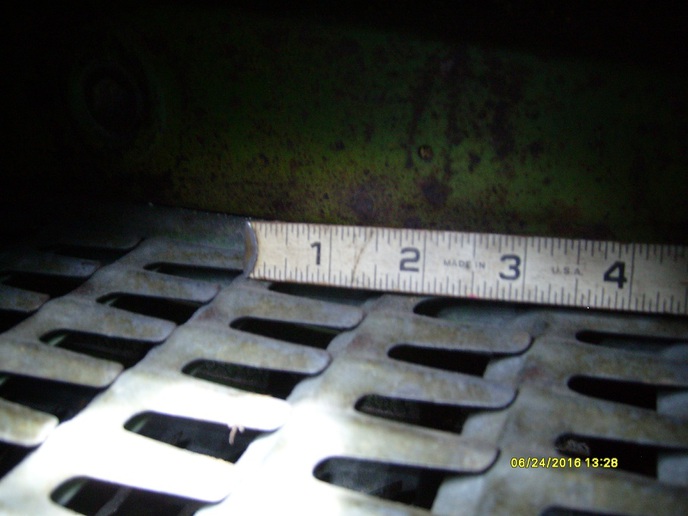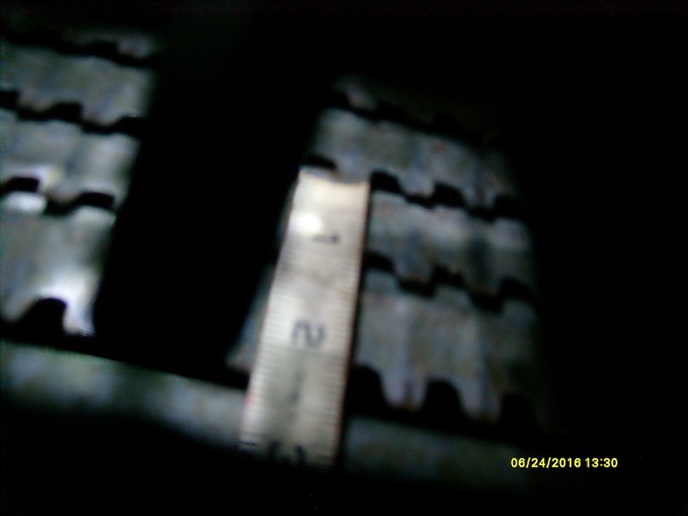How can I determine which chaffer/sieve we have in our JD 4420? Never seem to get a very good sample in small grain (wheat, oats, barley) but does good in beans and corn usually. Even when I think I'm doing good with the small grain sample in the bin I get a good bit going out the back ( get a good "second crop" ), just wondering if there is a different shoe setup I should have for small grains. Also only have the back curtain installed, make a difference for small grain? If so where can I get another one to put in.
You are using an out of date browser. It may not display this or other websites correctly.
You should upgrade or use an alternative browser.
You should upgrade or use an alternative browser.
- Thread starter Paul swpa
- Start date
Mike Aylward
Well-known Member
You can get a good sample with any of the screens but you have to make adjustments accordingly. Measure the distance between each row of finger rods to tell the spacing. Once we know which one you have we can help you. Mike
I bought a 4420 about 5 years ago. It came with two chaffer/sieves. One was for corn and the other for small grains. I had the JD dealer install the grain chaffer/sieve since I only combine wheat and oats. So I guess I would 1st determine which chaffer/sieve you have. Like Mike Aylward said, if you measure the distance between the fingers, I should be able to tell you which one you have. I get a very clean sample with wheat and oats and very little out the back. I believe my 4420 also has only 1 curtain installed. Al
Thanks Al. I have been curious as much as anything as to what is in our 4420 (got it about 4 years ago) because the manual lists three different chaffers in the settings section. We have been doing fairly well compared to others with the sample we get, especially last year I did real good with the wheat and oats, didn't see hardly anything behind the combine but a month later (oats mostly) fields greened up pretty good, need to find out what I'm not getting right. I almost think the threshed grain is getting caught in the straw going out the back that's the reason for the question about the curtain. Ours is positioned towards the back and thought I might need to move it forward. John Deere told me last year they are no longer available for the 4420.
Mike Aylward
Well-known Member
That is the deep-toothed, wide-spaced chaffer which will work just fine, even in small grains. You will tend to close it a little more than you would a small grain chaffer. As a general rule you will run the chaffer open enough to where you can insert your index finger. This is a starting point and you may have to play with it some. Run enough air that the chaff is floating off the chaffer. If you see two stripes of chaff on the ground after the combine has cut the grain you are not running enough air. The chaff is simply falling off the chaffer and hitting the pointed piece of sheet metal above the axle and splitting in two streams. The chaff should never hit this. On the sieve, keep it closed to do a good job of final cleaning without admitting too much material through the return. Mike
That cylinder speed of 1600 seems wrong and "1" on the concave seems very tight. What book are you looking at? I think the max cylinder speed on a 4420 is only about 1100. For wheat I run the cylinder at about 950 and the concave setting at about #2. The JD 4420 operator's manual suggests a speed of 800 to 1000 with concave from 2 to 6 for wheat. For oats I run the cylinder at 950 and concave around 4. Might open concave up to 8 if straw is very heavy and oats is very ripe. Manual suggests a cylinder speed from 700 to 1000 with concave from 6 to 7 for oats. Al
Thanks Mike, that is the chaffer I thought we had but wasn't sure. I do usually run as much air as I can without blowing grain out the back. Never had the two rows of chaff. We do cut pretty low, putting a good bit of straw through it depending on crop highth and weed content.
Al, I typically run cylinder speed starting fast then back off to see where it starts leaving unthreshed heads and take it back up some, if that makes sense. Concave set just wide enough not to crack grain. I think most of the time for wheat and oats I'm right around 1000 rpm on the cylinder speed and concave around 6 If I remember right, a little closer for wheat a little more open for oats. This is with a 216 grain head on the 4420.
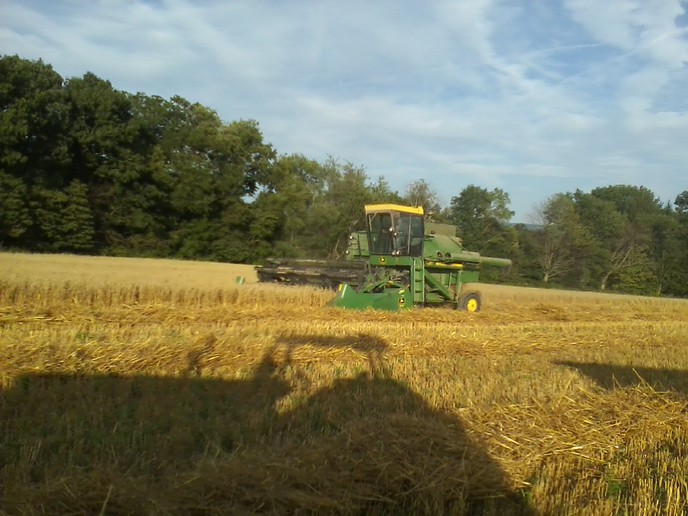

Paul, Those settings seem about right to me for wheat and oats. I don't think I have ever changed my cylinder speed of 950 since I got the machine. I only have a 213 head so I probably am not putting as much straw into the machine as you with a 216 head. And my ground speed is pretty slow too as usually don't go much faster than about 5 or 6 on the variable drive in 1st gear. I don't think my 4420 could handle a 216 head in my area as in good years I get 100+ bushel wheat and 130 bushel oats. My neighbor has a 216 head on his 6620 and another only uses a 915 head on his 9500. Al
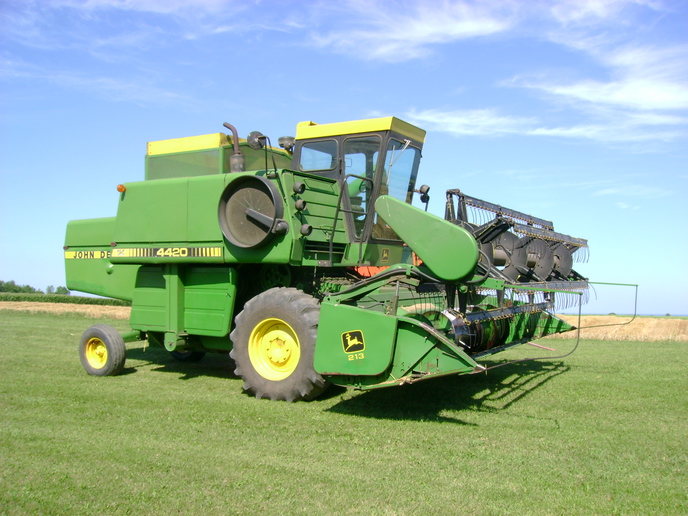

Al, I've often thought of getting a 213 head for the small grains as the combine came with the 216 flex head when we got it. It would sure make it easier getting down the road, I have to take the 216 off to go on the road around here - just too much traffic and too narrow of roads. I could only dream of those yields here. Mostly wheat runs around 40-45 bu./ac. and past few years oats have been around 50 bu., oats used to run 100+ bu./ac. all of a sudden yields just dropped like a stone. One year 120 bu. next only 45 bu.. This happened the same time we were changing combines and oat varieties.
I started years ago with an IH 80 pull combine dad bought new, first sp combine was an IH 205 good machine just not stable enough on our grades - had her on two wheels more than I cared to, next came a gleaner K2 - was little under capacity when I started shelling corn. (This is about the time oats yields dropped off.) Was looking for an F3 gleaner when we found this JD 4420 relatively close home at a used equipment dealer, It came out of IL. (has Greenline Equipment stickers on it). Last year I finally got dad up in the cab awhile doing oats, I walked along side checking what was going on and got it set a bit better (especially the air part), those oats in the picture above did around 60 bu./ac.. I think I was in 2nd. gear towards the slow end on variable speed. I usually start in 1st gear to see how things are going, adjust speed from there.
I'm just in the process of finishing up changing ground drive belts (were slipping at end of last season), decided while they were off to change separator drive belts as well (looked a little suspect and don't want to do in season). Thanks for all the help, Paul.
I started years ago with an IH 80 pull combine dad bought new, first sp combine was an IH 205 good machine just not stable enough on our grades - had her on two wheels more than I cared to, next came a gleaner K2 - was little under capacity when I started shelling corn. (This is about the time oats yields dropped off.) Was looking for an F3 gleaner when we found this JD 4420 relatively close home at a used equipment dealer, It came out of IL. (has Greenline Equipment stickers on it). Last year I finally got dad up in the cab awhile doing oats, I walked along side checking what was going on and got it set a bit better (especially the air part), those oats in the picture above did around 60 bu./ac.. I think I was in 2nd. gear towards the slow end on variable speed. I usually start in 1st gear to see how things are going, adjust speed from there.
I'm just in the process of finishing up changing ground drive belts (were slipping at end of last season), decided while they were off to change separator drive belts as well (looked a little suspect and don't want to do in season). Thanks for all the help, Paul.
Paul, I went over to my hobby farm this morning. That picture you sent is the same as what the my JD dealer called a corn chaffer. The fingers on my grain chaffer are about 1/2 as long and very little spacing between the fingers.
The combine history on my hobby farm is similar to yours. My dads 1st combine was an IH 64 with an engine he bought used in 1958. Then he bought a SP Massey Harris 35 in about 1969, then a used IH 93 and then an IH 205. I still have the 205 and last used it about 5 years ago. I bought the 4420 from my local JD dealer with the 213 head. Previous owner had it for 22 years before he upgraded to a JD 9410. I am a retired AT&T engineer and just hobby farm my dads 80 acre dairy farm near Green Bay, Wis. I only combine about 15 acres of wheat and 15 acres of oats each year. Attached is a picture of my 205. It was a good combine but I wanted a combine with air-conditioning. And the 4420 with the 213 head is about the largest combine I can get in my storage shed. Al
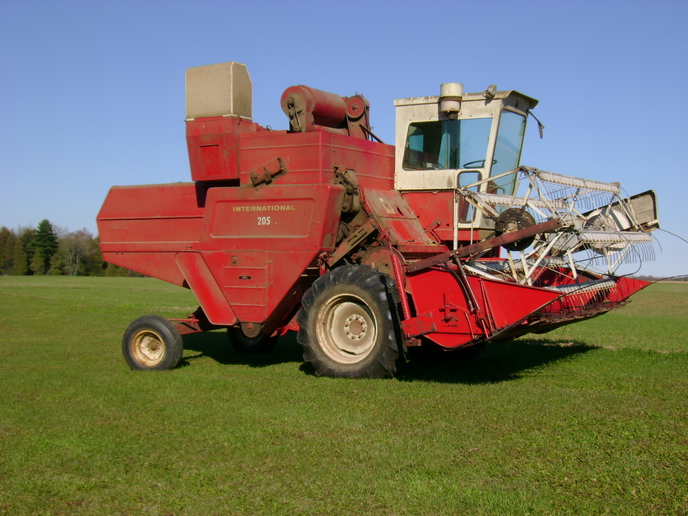
The combine history on my hobby farm is similar to yours. My dads 1st combine was an IH 64 with an engine he bought used in 1958. Then he bought a SP Massey Harris 35 in about 1969, then a used IH 93 and then an IH 205. I still have the 205 and last used it about 5 years ago. I bought the 4420 from my local JD dealer with the 213 head. Previous owner had it for 22 years before he upgraded to a JD 9410. I am a retired AT&T engineer and just hobby farm my dads 80 acre dairy farm near Green Bay, Wis. I only combine about 15 acres of wheat and 15 acres of oats each year. Attached is a picture of my 205. It was a good combine but I wanted a combine with air-conditioning. And the 4420 with the 213 head is about the largest combine I can get in my storage shed. Al

Thanks Al, the photo I uploaded is the only one we have of our IH 205. About the last good yielding oats we had. As you can see it didn't have a cab, couple neighbors had the same combine one had a parts unit we took the cab off, cleaned up and painted, but never got it put on. After I had her on two wheels I didn't think I wanted a cab to hinder my escape if I needed to! I just put a dust mask on to run her. Gave the cab to the guys that bought it from us - complete with a new fan motor.
Dad's first combine was a MM pull type sacker unit he bought new about 1952, he bought the IH 80 new to replace it. That's what I used for around 20 years til we got the 205. I still miss the 205 (even without the cab), just couldn't hang very well on half our slopes. There are a couple fields I wouldn't take the K2 or even the 4420 - it's just not worth it for a few bushels of grain. I have to travel to the ends of the fields where it flattens out some to even open the round baler - used to roll a hay wagon about every other year thinking I could make it back across one more time square baling. It's funny the only pictures I have of the combines are in the flattest fields.
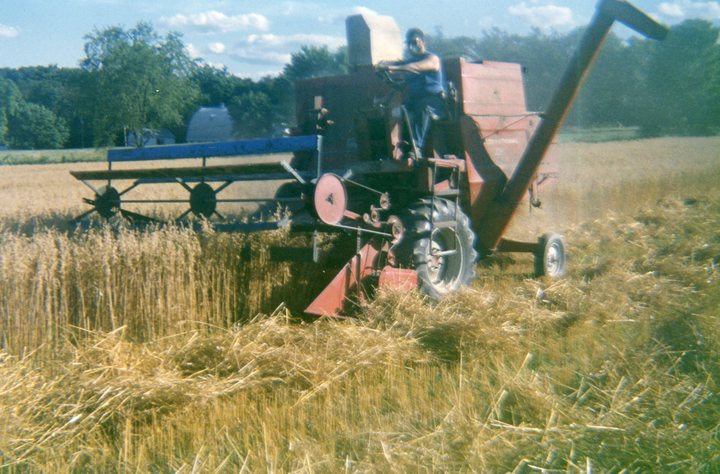
Dad's first combine was a MM pull type sacker unit he bought new about 1952, he bought the IH 80 new to replace it. That's what I used for around 20 years til we got the 205. I still miss the 205 (even without the cab), just couldn't hang very well on half our slopes. There are a couple fields I wouldn't take the K2 or even the 4420 - it's just not worth it for a few bushels of grain. I have to travel to the ends of the fields where it flattens out some to even open the round baler - used to roll a hay wagon about every other year thinking I could make it back across one more time square baling. It's funny the only pictures I have of the combines are in the flattest fields.

Mike Aylward
Well-known Member
You don't want to run the chaffer totally closed. You will end up with an effect similar to placing your thumb over a garden hose. You want air FLOW, not pressure. Start with the chaffer opened so you can place your index finger into the fingers. It's likely you will then go WIDER, not narrower. If you are cutting your straw low you are putting a load on the walkers and the shoe. It's usually best to just top the wheat and THEN mow the straw. You will save grain in doing so. For wheat, usually 1000 RPM is a good starting point. Oats usually only require 750-800 as they are much easier to thresh. Unless the wheat straw is very dry the heads should look like you shelled the wheat out by hand and not mutilated. Keep an eye on your return as you do any adjusting. You want very little chaff or grain going through the return. Too much grain means you have the bottom sieve too tight. Too much chaff usually means not enough air or possibly the chaffer too tight. Most people run too little air. One thing many do not realize is when seeing grain on the ground you probably need to UP the air instead of slowing it down. There is a window when a small additional amount of air will put more grain over but speeding up the air even more "floats" the chaff and allows much better and easier cleaning and more grain saved. Most grain is carried off the chaffer, not blown. Mike
Thanks Mike, I think I will have to print that out and put it in the manual for reference. I guess I spent too much time with the old IH 80, it's easier for me to set the combine from outside where I can see everything than from in the cab. Helped a neighbor out like that the other year. He was having a devil of a time getting his K2 set for wheat, I got it cleaned up for him in 10 or 15 minutes walking along side watching what it was doing.
Mike, one other thing, the manual talks of an air speed indicator on the 4420, I've never been able to locate it on ours. I have just been looking at the belt position in the variable sheaves. Last year I think I ran just on the fast side of even between the sheaves doing the oats, almost to the fastest doing the wheat. Does that sound like I'm in the ballpark for most conditions? Paul
Mike, one other thing, the manual talks of an air speed indicator on the 4420, I've never been able to locate it on ours. I have just been looking at the belt position in the variable sheaves. Last year I think I ran just on the fast side of even between the sheaves doing the oats, almost to the fastest doing the wheat. Does that sound like I'm in the ballpark for most conditions? Paul
Mike Aylward
Well-known Member
If you are floating the chaff and not putting excessive grain through the return you have it set pretty close. Use a hand tachometer to get a reference point if you need one. I never noticed what they called an indicator, either. Mike
Similar threads
- Replies
- 4
- Views
- 443
- Replies
- 8
- Views
- 1K
We sell tractor parts! We have the parts you need to repair your tractor - the right parts. Our low prices and years of research make us your best choice when you need parts. Shop Online Today.
Copyright © 1997-2024 Yesterday's Tractor Co.
All Rights Reserved. Reproduction of any part of this website, including design and content, without written permission is strictly prohibited. Trade Marks and Trade Names contained and used in this Website are those of others, and are used in this Website in a descriptive sense to refer to the products of others. Use of this Web site constitutes acceptance of our User Agreement and Privacy Policy TRADEMARK DISCLAIMER: Tradenames and Trademarks referred to within Yesterday's Tractor Co. products and within the Yesterday's Tractor Co. websites are the property of their respective trademark holders. None of these trademark holders are affiliated with Yesterday's Tractor Co., our products, or our website nor are we sponsored by them. John Deere and its logos are the registered trademarks of the John Deere Corporation. Agco, Agco Allis, White, Massey Ferguson and their logos are the registered trademarks of AGCO Corporation. Case, Case-IH, Farmall, International Harvester, New Holland and their logos are registered trademarks of CNH Global N.V.
Yesterday's Tractors - Antique Tractor Headquarters
Website Accessibility Policy


